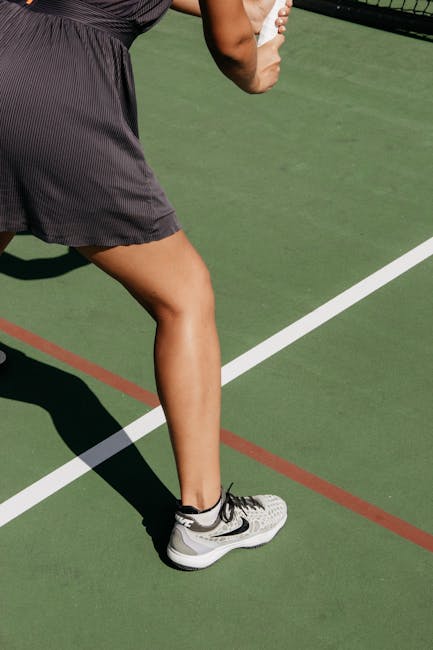Ah, tennis elbow – the bane of every gym-goer’s existence. You’ve suffered through the pain and the frustration, but you refuse to give up the iron paradise. Fear not, my fellow gym junkies – I have just the solution for you! In this professional guide, I will teach you how to lift weights with tennis elbow like a pro. Say goodbye to the limitations and hello to the gains. It’s time to lift, my friends! (cue Rocky theme music)
Contents
- 1 1. Introduction: Understanding Tennis Elbow and its Implications for Weightlifting
- 2 2. Diagnosing and Managing Tennis Elbow for Weightlifting Success
- 3 3. The Art of Lifting Weights with Tennis Elbow: Techniques and Tips
- 4 4. Developing a Safe and Effective Exercise Program for Weightlifters with Tennis Elbow
- 5 5. Conclusion: Overcoming Tennis Elbow and Maximizing Weightlifting Performance
1. Introduction: Understanding Tennis Elbow and its Implications for Weightlifting
So, you’ve got a pain in your elbow that makes it difficult to open a jar of pickles or lift a dumbbell. Don’t worry, it’s not the end of the world. You probably just have tennis elbow, which sounds fancy but is really just a fancy way of saying inflammation of the elbow tendons.
But what does this have to do with weightlifting, you ask? Well, if you’re a gym rat like me, you know that weightlifting requires a lot of elbow action. And if you have tennis elbow, lifting heavy weights might be a literal pain in the arm. But fear not, my fellow fitness fanatic, there are ways to manage your tennis elbow and still get your swole on.
First and foremost, it’s important to understand what causes tennis elbow. It’s often the result of repetitive motions, like swinging a tennis racket (hence the name) or lifting weights. So, if you’re a weightlifter, chances are you’ve been doing the same motions over and over again, which can put a strain on your tendons.
2. Diagnosing and Managing Tennis Elbow for Weightlifting Success
So you’ve been blasting those barbells and suddenly, you feel a sharp, shooting pain in your elbow. Congratulations, you’ve just earned yourself a ticket to Tennis elbow! Before you start mourning and convincing yourself that you’ll never be able to lift again, let’s talk about how you can diagnose and manage this pesky injury.
First things first, how do you know if you have Tennis elbow? Well, apart from the sharp pain, you may also experience weakened grip strength, stiffness, and overall soreness in your arm. If you’re still not convinced, try this easy test: extend your arm and flex your wrist, if there’s pain in the outer part of your elbow, you might need to take a break from lifting and focus on recovering from the injury.
Now, we know that taking a break from lifting sounds like a nightmare, but trust us, it’s worth it in the long run. To help with the recovery process, you can try some of these management techniques:
- RICE: Rest, Ice, Compression, Elevation. This is the golden rule for managing any kind of athletic injury. Rest your arm, apply ice, wrap your arm with compression bandages and keep it elevated to help reduce swelling.
- Stretching and strengthening: Exercises that focus on stretching and strengthening the muscles in your forearm can help reduce pain and prevent future injuries. Flexbar, wrist curls, reverse curls and hammer extensions are some exercises that you can try.
- Sports tape: This might sound like a crazy idea, but taping your arm can help relieve some of the pressure on your elbow and give you some relief. It’s a low-cost solution that you can try while you recover.
With these techniques, you’ll be back to lifting in no time.

3. The Art of Lifting Weights with Tennis Elbow: Techniques and Tips
The Art of Lifting Weights with Tennis Elbow: Techniques and Tips
So, you have a case of tennis elbow but you still want to lift weights? No problem! Here are some techniques and tips to help you lift without aggravating your condition:
- Start small: Don’t go for the heavy weights right away. Start with lighter weights and gradually increase the weight over time.
- Stretch: Take some time to stretch before lifting. Focus on the muscles in your forearm, bicep, and tricep to loosen up any tension and prevent further injury.
- Use proper form: Even with healthy elbows, using proper form is essential. But it’s especially important when you have tennis elbow. Make sure you’re lifting with your legs and not your back, and keep your elbows close to your body.
Another tip is to use a brace or support to help alleviate some of the pressure on your elbow. Many people find that using a brace during their workouts is helpful in reducing pain and stiffness associated with tennis elbow. And remember, listen to your body. If you’re feeling pain or discomfort, don’t push yourself too hard.
With some patience and determination, lifting weights with tennis elbow can be done. Just remember to take it slow and use the proper technique. And, of course, be prepared for some extra stares from gym-goers when they see you lifting weights with a fancy brace on your arm.
4. Developing a Safe and Effective Exercise Program for Weightlifters with Tennis Elbow
You know what they say, no pain no gain! But for weightlifters suffering from tennis elbow, pain is definitely not the name of the game. Developing a safe and effective exercise program can be tricky, but fear not, we’ve got you covered!
First things first, let’s talk about what NOT to do. Avoid exercises that put excessive strain on your elbow such as overhead presses, dips, and pull-ups. Instead, focus on exercises that target the muscles around the elbow, such as the biceps and triceps. Moves like hammer curls and tricep pushdowns are your new best friends.
Remember, Rome wasn’t built in a day and neither was your exercise program. Start slow and gradually increase your weights and reps as you build strength. It’s better to have a steady and safe progression than to push yourself too hard too early and re-aggravate your injury. Plus, nobody wants to be on the bench (or couch) indefinitely.
- Beware of the “no pain, no gain” mentality. Pain is your body’s way of telling you something is wrong and you definitely don’t want to make things worse.
- Consult a physical therapist or trainer who can help tailor a program specifically for you and your injury.
- And lastly, have patience! Healing takes time, but with a little persistence and care, you’ll be back to lifting heavy in no time.
5. Conclusion: Overcoming Tennis Elbow and Maximizing Weightlifting Performance
Prevention is better than cure: The key to overcoming tennis elbow is to avoid it in the first place. Proper form, warming up and cooling down, using the right equipment with the right grip size is essential. And oh! Don’t forget to fuel your muscles with proper nutrition. A well balanced diet can alleviate the symptoms of tennis elbow too. Also, try not to overdo it – constant strain can lead to a tennis elbow. So, if your trainer says “No pain, no gain,” run the other way.
Invest in wrist wraps: If you’re a weightlifting enthusiast and you’re out here trying to lift heavy without supporting accessories, then you’re playing yourself. Investing in the right kind of wrist wraps can help provide additional support to your wrist and most importantly help reduce the chances of tennis elbow altogether. It’s like wearing a helmet- sure, some people may laugh at you at first, but when you’re killing it out there and they’re nursing an injury, you’ll be smiling.
If you do get tennis elbow, don’t panic: First, rest your elbow. Maybe take a break (before the weightlifting withdraws kick in again) and avoid any activities that may exacerbate the pain. You can also apply some over-the-counter pain relief medications or ointments for some instant relief. Additionally, if necessary, seek medical advice from a professional. Remember that recovery takes time, so don’t just jump back into weightlifting as soon as you start to feel better – take it slow and steady till you’re fully back in the game.
Parting Thoughts (and Bicep Curls)
Well, there you have it folks – a professional guide to lifting weights with tennis elbow. We hope our tips have helped you overcome this pesky injury and get back to pumping iron like a champ.
But before you go, we want to remind you of one crucial piece of advice: always listen to your body. If you feel any pain or discomfort while lifting, stop immediately and consult a medical professional. And if all else fails, just remember – there’s always room for more bicep curls.
Now go forth and lift with confidence (and caution) – your gains await!








Leave A Comment